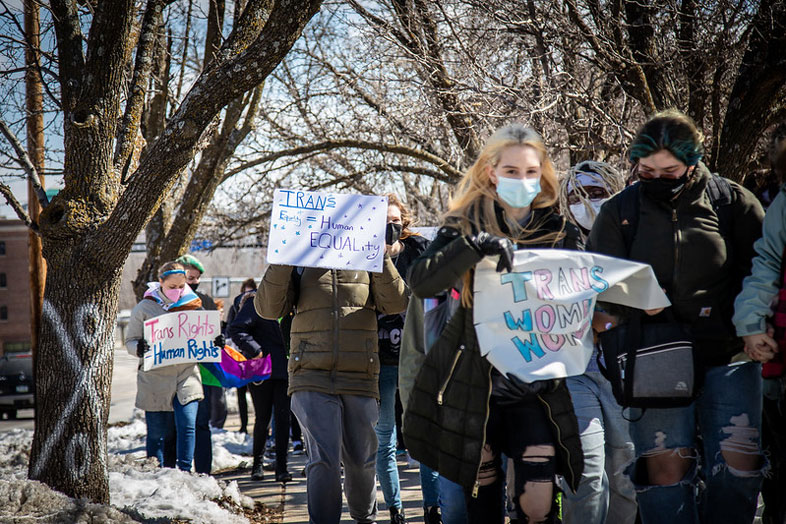
A Guide to the Guides: What to Know About LGBTQ Style Guides for Journalists
There are numerous LGBTQ style guides for journalists, so here’s a primer. This resource was last updated May 27, 2024.
Iowa students protest anti-trans law. (Phil Roeder/Flickr)
There are numerous LGBTQ style guides for journalists. Most include similar advice for what is and isn’t appropriate to ask gay and trans sources as well as how to steer clear of some oft-repeated misinformation.
Offering your pronouns — e.g. she/her/hers, they/them/theirs — at the start of a conversation invites your interviewee to reply with the information they want you to have about their identity.
Young people don’t always make good decisions about sharing information. If possible, have a parent present. If that’s inadvisable, perhaps a school’s gay-straight alliance adviser or another trusted adult can be tapped. It’s painful to acknowledge, says Francisco Vara-Orta, a former Education Week staff writer and EWA board member who is now director of diversity and inclusion for Investigative Reporters and Editors. But as a gay man in an era where elected officials feel free to say LGBTQ adults are pedophiles, he tries not to talk to children alone.
It’s almost never appropriate to ask about a person’s anatomy or the medical details of their transition. Because an evolving base of scientific knowledge has identified sex and gender as complicated and not necessarily fixed, it’s also inappropriate — and politically charged — to refer to a person’s biology, e.g. “biologically male.”
Contrary to heated rhetoric, gender-confirmation surgery is generally not performed on minors. Puberty-suppressing drugs are fully reversible and temporarily stop the development of permanent secondary sex characteristics, such as Adam’s apples and breasts.
Do not “deadname,” or use the pre-transition name, of a transgender person unless they invite you to.
Here are style guides and other resources to better cover LGBTQ students:
Style Guides
- AP Stylebook created its Transgender Coverage Topical Guide in 2022. It offers terminology, red flags and several entries, including ones on pronouns and deadnaming. (Signing in to view the guide may be required.)
- NLGJA: The Association of LGBTQ Journalists offers a style guide and a “toolbox” with guidance on journalistic issues, such as ensuring balance while avoiding sensational but discredited storylines.
- The GLAAD Media Reference Guide has helpful information for covering LGBTQ people’s participation in a variety of civic and social arenas.
- Trans Journalists Association provides a style guide that includes terminology, suggestions for improving representation of gender-nonconforming people in coverage, cautions about supposed experts most qualified professionals consider “fringe” sources and other easily mishandled items.
Best Practices for Reporting on Trans and Nonbinary People
Columbia Journalism Review
- The complexities and nuances of transgender coverage
- Five tips for journalists on covering trans and nonbinary people
NBCU Academy
- How journalists can improve their coverage of the trans community
- Reporting on the transgender community
The Open Notebook
Education Legislation
LGBTQ Youth and Health Care
- Covering LGBTQ+ health and health care: Reporting tips and story ideas from The Journalist’s Resource
- Getting it right: Reporting on laws that prohibit gender-affirming care for minors from Association of Health Care Journalists
- Policy Tracker: Youth Access to Gender Affirming Care and State Policy Restriction from KFF
- The rise of anti-trans bills in the US from Reuters
- What states are restricting transgender health care from Axios
Data, Research and Tools
Note: Data has limitations, but there’s increasingly available data.
- Centers for Disease Control and Prevention Youth Risk Behavior Surveillance System, a set of surveys that track behaviors that can lead to poor health in students grades 9 through 12.
- GLSEN: Its school climate survey includes detailed information on in-school harassment and discrimination.
- Movement Advancement Project: See state-by-state information on laws and policies; it’s updated frequently with useful underlying notes on data.
- National Federation of State High School Associations: It maintains athletic participation data and provides Title IX compliance guidance (available on its website) to education leaders.
- RAND American Educator Panels: Find data on teacher perceptions.
- Source, an Open News Project: 7 tips for data-driven journalism about LGBTQ+ communities
- The 19th and SurveyMonkey, “The State of Our Nation”: The poll details what LGBTQ+ people and women think about political issues.
- Transathlete.com: It has resources on numerous organizations’ rules and includes terminology.
- Trevor Project Survey: It shares the experiences of LGBTQ people ages 13 to 24. The 2023 survey included participation from more than 28,000 people.
- Williams Institute at UCLA School of Law: It conducts independent research on sexual orientation and gender identity law and public policy. Several reports are available.
- University of Southern California Dornsife Center for Economic and Social Research’s Understanding America Study: Recommended studies include those by researcher and professor Morgan Polikoff, who was interviewed about a recent study.
- U.S. Census Household Pulse Survey: Measuring Emergent Social and Economic Matters Facing U.S. Households
- U.S. Office for Civil Rights’ Open Investigations: OCR publishes this list of elementary-secondary and post-secondary institutions that are currently under investigation.
- U.S. Trans Survey: This is the largest-ever survey of transgender people in the United States. The most recent survey is from 2022.
Finding Stories Using Public Records
Where to Look:
- Legal filings
- Municipal/district-specific health and youth/student experience surveys and assessments.
- For example, New York and Chicago both have nonbinary student data specifically. Additionally, many other districts do extra studies on LGBTQ+ data that may not be available at the state or national level.
- Legislation and written policy language
- School board hours and records

